To celebrate the release of The Dark Knight Rises, July is “Batman month” here at the m0vie blog. Check back daily for comics, movies and television reviews and discussion of the Caped Crusader.
I have to confess, I think that Adam West’s Batman! gets a bit of an unfair time from comic book aficionados, movie fans and even casual pundits. In the years since the iconic movie and television show, fans have acted like camp and comedy are elements that have no place in the world of the Caped Crusader. There is – of course – a reason for that. Darker portrayals have since come dominate Batman’s characterisation, from Tim Burton’s Batman to Frank Miller’s The Dark Knight Returns to Christopher Nolan’s The Dark Knight. However, I think one of the most endearing aspects of Batman as a pop culture icon is his ability to adapt. “I’m whatever Gotham needs me to be,” Batman tells Gordon at the climax of The Dark Knight. Sure, sometimes we need him to be a staunch and iconic hero triumphing against adversity. Other times we simply need him to whip out the Bat Shark Repellent.
Watching Batman! again for the first time in years – and for the first time in High Definition – I’m amazed at how well the film holds up. It’s a shame that the rights for the associated television show are so tied up, because it would be wonderful if it looked half as good as this does. Sure, the special effects are decidedly dated. The cuts are glaringly obvious. However, these just add to the candy-coated hyper-realism of the film. This not the world as it exists or ever could exist. This is the world as seen through a deliciously childish imagination.
The model work is superb throughout. Sure, there’s the occasional failure – a henchman is launched through a window and a Ken doll lands in a puddle, for example. However, the Penguin’s submarine looks fabulous. The sets look lavish while still clearly fake. The Batcave is like a pop cultural museum, with the exhibits clearly and lovingly labelled. Leslie H. Martinson’s direction is fun and relaxed, keeping the cast loose while energetic. Nelson Riddle’s score is fun and every ounce as iconic as it was when originally recorded. Even looking at the pictures for the review, I can’t help but hum some of that wonderful score.
Returning to the film after so many years, I have a new found appreciation for Adam West as Batman. He isn’t my favourite Batman by any means, but he is superb. He might lack the material that elevated Conroy and Bale, or the introspection that helped define Keaton, but West is still significantly more comfortable and enjoyable in the lead role than either Val Kilmer or George Clooney ever were. There’s a sense that West is entirely comfortable in his own skin, and his performance is endearingly and delightfully self-deprecating – an exceptionally witty and self-aware portrayal.
In a world populated by tricksters in silly outfits with goofy laughs and ridiculous gimmicks, even the guy dressed as a bat tends to fade to the background. As a child, Batman was probably the lest engaging part of the show – I was more fascinated with the Joker, Riddler, Catwoman or Penguin. As an adult, West’s Batman seems a lot more interesting. A glaringly ironic portrayal of the character as, according to the Joker, a “square citizen.”
The opening sequence alone treats us to the cringeworthy sight of Batman offering an embarrassed and awkward thumbs up to saluting police officers from his Bat-copter. Adam West is tasked with wrestling a rubber shark. He’s on-hand to deliver delightfully self-evident morals to Robin. After saving a bar full of sleazy patrons, he reminds his sidekick, “They may be drinkers, Robin, but they’re still human beings.”
This version of Batman is such a pion of righteousness that he laments not only the loss of any human life, but any life whatsoever, regardless of the cartoonish circumstances. He describes the poor shark caught in his foes’ machinations as “an unfortunate animal.” Robin points out that the villains stuffed the monster with TNT before unleashing it. (Clearly, a shark alone is no match for Batman.) Batman seems ready to avenge the hapless beast. ”Is nothing sacred to these devils?” he demands. Later on, Robin take a moment to acknowledge the finned friends who helped the duo avoid death at the hands of the Penguin. “Gosh, Batman. The nobility of the almost-human porpoise.”
It’s interesting to look at a time when Batman existed as part of Gotham City’s social structures. While Bob Kane had originally written him as a vigilante hunted by the police while hunting criminals, that depiction soon softened. At around the same time of this movie, the Batman of the comics was giving speeches at graduation ceremonies, holding press conferences and hanging out with an amateur bunch of mystery investigators.
Miss Kitka suggests, “You are like the masked vigilantes in the Westerns, no?” Commissioner Gordon is quick to shoot down that comparison. “Certainly not!” he protests. “Batman and Robin are fully deputized agents of the law.” It’s funny because I’m imaging Batman attending pension meetings and filing paper work. Batman is such an essential part of the city’s infrastructure that he even keeps his gadgets in the custody of the city. Driving to the airport, he phones ahead. “Prepare Bat-copter for immediate take-off!” (I love the way one the extra blandly announces, “Batmobile approaching Bat-copter.”It seems like that’s a regular sight in Gotham.)
Consider the justification that Batman and Robin give here for their secret identities. It doesn’t hinge on being arrested for vigilantism, or psychotic villains seeking retribution and revenge. Apparently it would just impact their effectiveness as crimefighters. Bruce explains, “If Robin and I were to remove our masks, the secret of our true identities would be revealed.” Gordon elaborates, “Completely destroying their value as ace crimefighters.” All this allows Robin to state a clear moral. “Support your police! That’s our message!”
And yet the series still had a refreshingly cheeky irony about it. Not just in the gratuitous double entendres or in-jokes. Trapped to a giant magnet as a torpedo hurdles towards them, Batman confesses, “It’s got us by the… metallic objects in our utility belts!” There’s also a bit of sly satire here as well. The members of the United Nations World Security Council are too busy bickering to notice a cadre of costumed criminals in their wake.
Two decades before the Iran-Contra Affair, we get to hear Batman sternly rebuke a negligent military official who sold a submarine to a “Mister P. N. Guin.” Batman is horrified when the fiend only need a P.O. Box address to pick it up. “Your tone sounds rather grim,” the Admiral states. “We haven’t done anything foolish, have we?” Batman tries to mask his frustration. “Disposing a pre-atomic submarines to persons who don’t even leave their full addresses… Good day, Admiral!”
Adam West is the perpetual straight man to the insanity around him, reading ever line as if he were to be crushed beneath its weight. It’s a fantastic portrayal that works very well with the material – in fact, it helps Batman stand out in his own way against his more colourful foes. I suspect that West’s performance actually helped crystalise the “straight man”portrayal of Batman, especially when juxtaposed against the Joker’s insanity.
And yet there’s something curiously human about West’s Batman as well. While Bruce Wayne is much more of a shell here than he would be in Nolan’s films or the animated shows featuring the character, West is careful to give Bruce Wayne more than a slight hint of vitality. His pursuit of “Miss Kitka” is perhaps the most red-blooded I’ve ever seen Bruce Wayne. “Your jargon is quaint, Miss Kitka,” he patronisingly tells her, while making flirty eyes.
Once Wayne sets his eyes on “Miss Kitka”, he pursues her with vigour. There’s none of the awkwardness that Michael Keaton would bring to Bruce Wayne’s romances, and he’s clearly less guarded than Christian Bale. He even makes several overt double entendres to and about her. Talking with Alfred, he confesses, “I’ve rarely met a girl who’s such a potent argument in favor of international relations.” Later on, discussing his dream with her, he explains, “It approaches a climax.” Miss Kitka isn’t having that, responding, “Nyet. Not so fast. Be more slow.”
Of course, it wouldn’t be Batman if the relationship wasn’t at least a little bit creepy. Appropriately enough, Wayne’s idea of romantic poetry comes from Edgar Allan Poe, of all places – hardly the healthiest of guides in the area of love. While Heath Ledger’s Joker might have been confused about how to get Batman to break his “one rule”, it turns out that distracting Wayne from his date might do the trick. The world’s greatest detective, apparently fooled by a domino mask, is unable to identify Miss Kitka as Catwoman, and vows to the fiends, “I swear by heaven, if you’ve harmed that girl, I’ll kill you! I’ll rend you limb from limb!”
Adam West could be hardcore when he wanted. In fact, he’s at his most morally outraged when the villains interrupt his romantic evening. He frequently referred to his fiendish foes as “miscreants”, but here he seethes with anger. “You filthy criminals,” he hisses. I get the sense that The Dark Knight, for all its darkness, might have been a far shorter movie had it featured Adam West’s version of the character. The moment the Joker touched Rachel, I don’t doubt West would have “rend” him “limb from limb.”And this version of Gordon probably would have been such a pushover he wouldn’t have prosecuted.
Of course, despite the intense and possessive playful flirting of the sixties, this version of Batman is still very much a figure of childish fantasy. He doesn’t consummate his relationship with Miss Kitka beyond anything more than a kiss, and instead proves his undying love for the woman he just met by knocking seven kinds of stuffing out of the bad guys in what is actually one of my favourite Batman related action sequences ever. Nolan might have flipped a truck, set a new standard for bank robbery and demolished a real plane, but he didn’t give me a scene of Bruce Wayne single-handedly taking down an entire army of pirate themed goons (and four of his most iconic baddies) without any attempt to hide his badassery.
This is a very fun and fantastic Batman – undoubtedly one of the few iterations of the character that you could legitimately expect a kid to aspire to be in a “I wanna be Batman when I grow up” kind of way. I think the Wayne murder was mentioned once on the show, and isn’t even alluded to here. Instead, he has all manner of cool “Bat-“ branded goodies, right down to a “Bat-ladder.”I suspect Alfred got Bruce a labelling machine for Christmas. Instead, Bruce gets to flirt with beautiful women, beat up exotic bad guys and just be incredibly awesome.
His life is so fantastic that he even has a way of avoiding the most boring part of being a Caped Crusader. His “Instant Costume Switch Lever!” means that Bruce doesn’t even have to worry about putting on his tights when he wants to go from super-rich socialite to badass rock star of justice. In fact, the Batmobile even runs on “atomic batteries” (complete with a hard water dispenser in the Batcave), which feels like Bruce just makes whatever comes into his head. “I want an atomic-powered bat-themed car!”
It is worth noting that the script is completely insane. It did, after all, give us this gem:
Batman: Pretty fishy what happened to me on that ladder.
Gordon: You mean, where there’s a fish, there could be a Penguin.
Robin: But wait! It happened at sea! See? “C” for Catwoman!
Batman: Yet — that exploding shark was pulling my leg!
Gordon: The Joker!
O’Hara: It all adds up to a sinister riddle… Riddle-er. Riddler?
And they are completely and utterly right.
I also love how Batman and Robin are both perfectly correct when it comes to deciphering the Riddler’s riddles and what they mean.
Batman: Look at this pair of joking riddles.
Chief O’Hara: What does a turkey do when he flies upside down?
Robin: He gobbles up!
Chief O’Hara: Of course.
Batman: And, number two…
Commissioner Gordon: What weighs six ounces, sits in a tree and is very dangerous?
Robin: A sparrow with a machine gun!
Commissioner Gordon: Yes, of course.
I suspect that part of the reason the Riddler is so insanely fixated on Batman and Robin is because they are probably the only two people on the planet who “get” him.
Of course, all this ridiculousness is decidedly intentional. There’s no way that the writers weren’t giggling away to themselves as they wrote these lines. To be fair, none of this is too far from the comics of the time, despite what some fans would argue. After all, the first episode of the show was adapted from an earlier comic. (It was only the third comic to feature the Riddler, but the show’s use of him elevated him to the status of one of the iconic Batman villains.) At one point, Bruce literally refers to a convenient plot device as a “contrivance.”
Still, the movie heads along fast enough that the ridiculous plotting is never too distracting, and the insane logic of the characters never becomes tiresome. There are any number of great sequences here – from Batman wrestling with a shark, to Bruce Wayne battling the rogues to Batman running around with a bomb to a good old “ka-pow”style fist-fight. That said, I will confess that the movie’s ending doesn’t feel especially satisfying, as Batman force the submarine to the surface and just punches up the bad guys again. It might seem more impressive if he hadn’t already done that. Still, getting there is half the fun.
I have to acknowledge that I adore the storytelling style used in the show. Watching the show is about as close as you can get to the sensation of reading a vintage sixties Batman comic book. Indeed, it’s often better because there’s a lot more irony here. From the ridiculous plot twists to the superb narration from Desmond Doomsday (really producer William Dozier) through to the fact that hitting villains appears to cause minor explosions, Adam West’s Batman! is literally a sixties comic book brought to life, with all the camp and vigour that it deserves.
I will confess that I have a fondness for many of the villains from the show. I think there’s something to be said for a 100 minute movie providing a team-up of four villains when a lot of two-hour films can barely manage a pair. While the characterisation might not be especially nuance or complex, I think the writing is consistent and efficiently defines each of the villains involved. I also love how Batman quantifies the threat posed by a supervillain team-up:
Commissioner Gordon: Penguin, Joker, Riddler… and Catwoman, too! The sum of the angles of that rectangle is too monstrous to contemplate!
Batman: We’ve been given the plainest warning. They’re working together to take over…
Chief O’Hara: Take over what, Batman? Gotham City?
Batman: Any two of them would try that!
Commissioner Gordon: The whole country?
Batman: If it were three of them, I would say yes, but four? Their minimum objective must be… the entire world.
While it’s certainly far from my favourite portrayal of the Clown Prince of Crime, I do have a soft spot for Cesar Romero as the Joker. I must concede that you know there’s a problem when the Joker is arguably the least defined and the least compelling of Batman’s assembled foes, but there’s just something so delightfully entertaining about the villain seen here. He has such style. And he takes such glee in absolutely everything. With the fiendishly complicated death trap set, it’s the Joker who boasts, “It’s all set! He puts his foot here, my jack-in-the-box fires, shooting him through the window and into the arms of Penguin’s exploding octopus. What a deliciously humorous trajectory!”
Lee Meriwether was actually my favourite of the three actresses to play Catwoman during the show’s run. (Julie Newmar played her during the first and second seasons, with Eartha Kitt filling in during the third season. This is Meriwether’s only appearance in the role.) I admit that it might just be a purely superficial thing. She makes that catsuit look damn good. That said, she does a wonderfully goofy Russian accent and matches Adam West’s cheesy flirting with gusto.
And she has my favourite sixties Catwoman moment while meowing and hissing as she looks through the periscope. (It’s a great scene, as she weirds out the dude in a pirate costume next to her.) That said, I really thought the film kinda over-did the “cat” thing. She sorts seems like the crazy cat lady of these assembled goons, wandering around with her cat and using it, evidently, to sniff out the weak spots in otherwise secure-looking doors. Still, that’s hardly a complaint.
However, it’s the Riddler and Penguin who steal the show. Both have arguably never been better as villains than they are here. I mightprefer Danny DeVito’s gothic camp Penguin by the slimmest of margins, but Burgess Meredith is just amazing as the foe here. All the actors playing the foes are having great fun, but Meredith seems intent on chewing any piece of scenery he can get his hands on, somehow managing to make those delightfully surreal quacking noises while still holding a cigarette in his mouth.
There’s a wonderful sequence in the middle of the film where – no foolin’ – the Penguin dehydrates some goons and tricks Batman into letting him into the Batcave by posing as a missing inventor. Meredith is having the time of his life, playing the Penguin undercover, as he half-heartedly tries to stop making his squawking noises and maniacal giggling. All the villains play their roles with gusto, but Meredith seems to go the extra mile. I love that scene of the villains riding flying umbrellas. The rest of the cast are enjoying it, but Meredith is actually bouncing up and down with one hand on his hip, like a general riding his steed into battle. And it is awesome.
I like how, even with all the silliness and camp, all of the villains are consistently characterised. The Joker is the easiest to get along with of the bunch, and seems to be involved because he had nothing better to do. Catwoman actually seems a little embarrassed to be working with the other three, and is actually the most serious of the bunch. However, if you watch closely, the Penguin and the Riddler seem to absolutely hate one another’s guts.
I’m not sure if it was written that way – certainly the lines are there – or if it’s a result of Meredith and Gorshin both giving a masterclass in glorious scenery-chewing, but it’s repeatedly evident that the Penguin and the Riddler clearly despise one another during this little team-up. The Penguin seems to delegate the most demeaning tasks to the Riddler – like walking to the door and ordering the goon outside to order some other goons. And the Riddler seems to resent it.
When Catwoman tells the Riddler that the Penguin must have finished off Batman, the Riddler indignantly replies, “Why, that stupid waddling mountebank of a bird? He couldn’t finish a bag of popcorn!” Later on, after a confrontation between Penguin and the dynamic duo, the Joker is his amicable self and observes, “I hope Penguin made it.” The Riddler doesn’t seem quite so upset at the possibility of the Penguin dropping out this team-up. “Who needs him?”
Frank Gorshin is the Riddler. The character had two Golden Age appearances in Detective Comics, and just so happened to make one appearance during the Silver Age that happened to be chosen as the story to be adapted as the pilot of the new Batman! television show. He was, to be fair, a B-list villain at the very best. The fact that the Riddler is in anyway as iconic as Catwoman or the Penguin is pretty much entirely down to Gorshin. In fact, Gorshin actually invented the character’s “green leisure wear” look when he found the green tights too uncomfortable to wear all the time.
Chris Sims, respected Batmanologist, would argue that Gorshin’s portrayal was a spiritual predecessor of Heath Ledger’s Joker, and it’s hard to argue. Certainly there’s a lot more of Gorshin’s manic interpretation of the character in Ledger’s Joker than there is any hint of Romero or Nicholson. Sure, the Joker of The Dark Knight had a stronger philosophical grounding and a much more sinister methodology, but the portrayal is familiar. Gorshin has this remarkable ability to push the character from perfectly cold and calculating to outrageous and insane in a matter of seconds.
There’s a wonderful level of unpredictability to Gorshin’s Riddler. One could see him conversing perfectly amicably one minute only to be screaming in an out-of-control fashion the next. While all of Batman’s foes here obviously have their hang-ups, the Riddler is the only character who seems truly deranged. The Joker, Catwoman and the Penguin are all functioning villains who have adopted themes that they adhere to. There’s something far more compulsive about the Riddler’s behaviour.
The Riddler has no choice but to leave riddles for Batman, even though they inevitably get him caught. “I must!” he shouts at one point, as the Joker tries to talk him out of it. “I must!” He doesn’t even attempt to justify his compulsion, he simply states it as a need. You know that you have psychological problems when any version of the Joker seems to appeal to your sanity. Romero’s Joker, ever the nice guy baddie, pleads, “Riddler, come back!”
It is, after all, the Riddler who gets the villains arrested and caught by Batman, because he couldn’t resist his own urges. This is an aspect of Gorshin’s portrayal that build on something only fleetingly hinted at in the comics, and indeed would become a major psychological cornerstone of the character. (Of course, Gorshin’s performance is pretty much the definitive take on the Riddler, to the point where Jim Carrey in Batman Forever just affectionately channels him. Sadly, without the very faint hint of darkness Gorshin brought.)
I still can’t believe that the series is unavailable on DVD or blu ray, due to rights issues. It’s a cultural landmark, and I think it’s an iconic interpretation of Batman and his world. I don’t think it’s as definitive or as fundamental as Batman: The Animated Series, and I don’t think it’s as essential and efficient as Christopher Nolan’s Dark Knight trilogy, but it’s still a fun and enjoyable piece of Batmanlore. I think it’s fair to argue that Batman would be anywhere near as ubiquitous today without this show.
The film is basically a two-part episode of the show shot with a bigger budget and a tiny bit more energy. In short, it encapsulates this take on the character perfectly. I have a soft spot for Adam West’s Batman!, and this movie was a key part of my childhood affection for the pop culture icon. Watching it years later, I can confirm that it still is.
Filed under: Non-Review Reviews | Tagged: adam west, batman, bruce wayne, Christopher Nolan, ChristopherNolan, dark knight returns, Dark Knight Rise, Dark Knight Rises, DarkKnight Rises, film, gotham city, joker, Movie, non-review review, Penguin, review, riddler, robin, tim burton |


















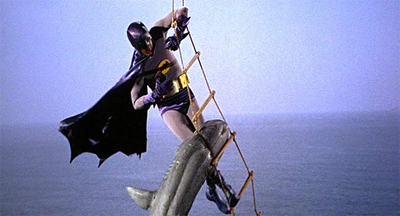

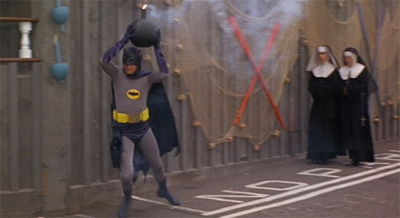


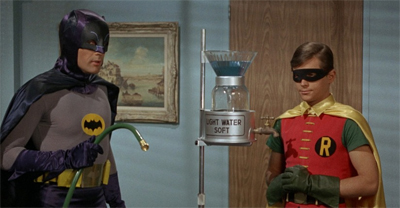





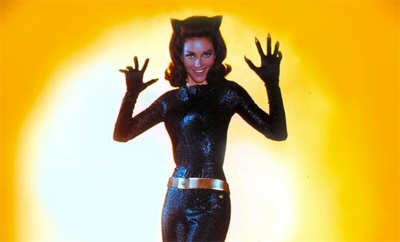

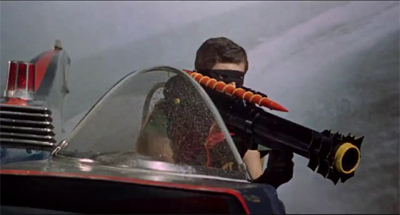

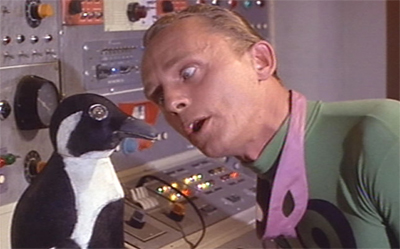







While I did very much like this movie, I found it a bit tiresome by the end. There is only so much silliness I can stomach and maybe 100 minutes was a bit too much for my taste.
I found it a little weird that the Joker was a subordinate to the Penguin. Maybe it’s due to the portrayals in the animated show and the two movies, but I find it hard to picture him as anything as his own boss.
I feel weird watching it, because the Joker has become a lot darker since Romero’s portrayal. Don’t get me wrong, Romero – like all of the “special guest villains” – was fun to watch and clearly having a great time, but his Joker definitely felt a bit generic. Like replace Jokes with Egypt and you’d have King Tut. Whereas the Penguin, Riddler and Catwoman all have their own personalities.
I do find it interesting, if you watch closely, that the Joker seems the most amicable of the entire bunch. The Penguin hates the Riddler, the Riddler hates the Penguin and Catwoman feels demeaned by having to associate with the trio. The Joker, on the other hand, is actually a fairly nice guy. He tries to convince the Riddler not to send a riddle, but isn’t aggressive or threatening about it (the Penguin would have swung for him). The Joker is also the only one of the bunch who seems to hope that Batman doesn’t knock seven shades of stuffing out of the Penguin during the confrontation in the cave.
Given how sinister and psychotic the character became, it feels quite… odd for him to be the best adjusted of the bunch.
This is my favorite Batman film.
It’s also, I think in some ways, the most realistic Batman film. The vehicles were real vehicles with no special effects involved, and when Batman exits a skyscraper window he first opens the window, ties his rope to the sil, then climbs out and abseils down slowly. it might not be dramatic but there’s no suspension of disbelief anywhere in the process.
I don’t know. Bat Shark Repellent requires as much disbelief as the imaging system at the end of The Dark Knight. As does turning people into dust that can be reformed.
I do love, however, that the final bit of The Dark Knight Rises is one gigantic tribute to the fantastic “somedays you can’t get rid of a bomb” bit.
Awesome photos’ – great memories!
Yep, a great piece of pop art, if you ask me!
I love the darker versions and the lighter in tone versions. Adam West’s Batman was silver age all the way. The silver age batman would beat you down while grinning,it was actually kind of unsettling.
Frank Gorshin’s Riddler has never been properly equalled in large part because this Riddler is more of an inspiration for Bronze Age and Iron Age Jokers than is the Silver Age Joker.
Modern Joker’s menacing intensity, obsession with The Batman, psychopathic level of mood shifts, tendency to lecture people about how the world works: all come from Gorshin’s Riddler rather than from the Silver Age Joker.
Yep, Bill, that’s a very valid point. I was rewatching some of the show recently, and Gorshin is just captivating as the Riddler. He is one of the few 1966 villains who exudes genuine menace. You can see his influence on the Nicholson/Ledger Jokers.
In many ways, Ceasar Romero’s Joker is the perfect Silver Age Joker, but his Joker also includes a quintessential Joker trait that worked as well with almost all other interpretations of the Joker, including Hamil’s animated Joker and Nicholson’s & Ledger’s Joker: The Joker really has no goal except his own amusement.
The Joker merrily follows The Penguin’s directives because that way he doesn’t have to be bothered with the tedious details of administration and can focus on having fun. He merrily follows The Riddler’s schemes whenever The Riddler is planning something amusing but also soberly confronts The Riddler about writing ransom notes that are not difficult to deciper.
In the movie, The Catwoman is driven by a desire for money and luxury, The Penguin is driven by patrician pride, and The Riddler is driven by an almost desperate need for a battle of wits, but The Joker really doesn’t care about anything except amusing himself, and this Joker would probably give up crime without a second thought if he found something more amusing — which he can’t in the “square” world The Batman promotes. (This last difficulty is carried on in the 1960s TV series, in which The Joker is more likely than any other Bat-foe to attach to the latest trends only to have those trends cut down by the “square” Batman: out of all 1960s Bat-foes, only The Joker would do something such as start an avant garde art school (in which Bruce Wayne enrolls mostly so he can condemn modern art) and try to defeat The Batman in a surfing contest just when surfing movies were popular.)
I like that. It’s a fantastic interpretation of the character. (Well, characters.) That said, I’d argue Ledger’s Joker is arguably more interested in his own validation than his own amusement, very much a post-Killing Joke Joker. (Which is ironic, since Tim Burton claimed to have adored The Killing Joke, but it had a minimal impact on Batman 1989.)
I don’t hate Adam West’s Batman. In fact, I kind of love it. I believe it’s an essential adaptation if Batman is a redefinable character. That said, I do hate that after all the work Danny Oneil/Steve Engelhart/Frank Miller/Alan Moore/Tim Burton/Bruce Timm/Jeph Loeb/Christopher Nolan have done revitalizing the characters public image after this interpretation kind of destroyed it, that people still remember and think of this as the defining version of Batman. I have no problem if this is someone’s favorite version, I would just like them to realize Batman is a mature literary character first and not the subject of BOOM POW jokes.
I think he can be both a mature literary character and the subject of BOOM POW jokes. I think that the number of people who consider West be the version of Batman are very small, but I think there’s nothing wrong with considering him a Batman. And I think that excluding him from discussion as a fairly significant piece of Batman history does a disservice to the flexibility of the Batman concept. (I love that in-story and out-of-story, Batman’s primary strength is his ability to adapt to the world around him and to become what he needs to be.)
Like Star Trek can be both an incredibly important piece of pop culture and a very silly fake-looking sixties sci-fi romp.
I do think there’s a need for Adam West’s Batman so as the darker interpretations don’t smother the character.